Arts & Entertainment Community
Gig Harbor Now and Then | STOP and read this yellow journalism
Our previous question of local history was derived from a rule having been mandated by the Manual on Uniform Traffic Control Devices for Streets and Highways that all stop signs produced from 1954 on would be of a new color scheme.
Arts & Entertainment Sponsor
Arts & Entertainment stories are made possible in part by the Gig Harbor Film Festival, a proud sponsor of Gig Harbor Now.
What color were stop signs before the mandated change to red with white letters in 1954?
Answer: yellow with black letters.
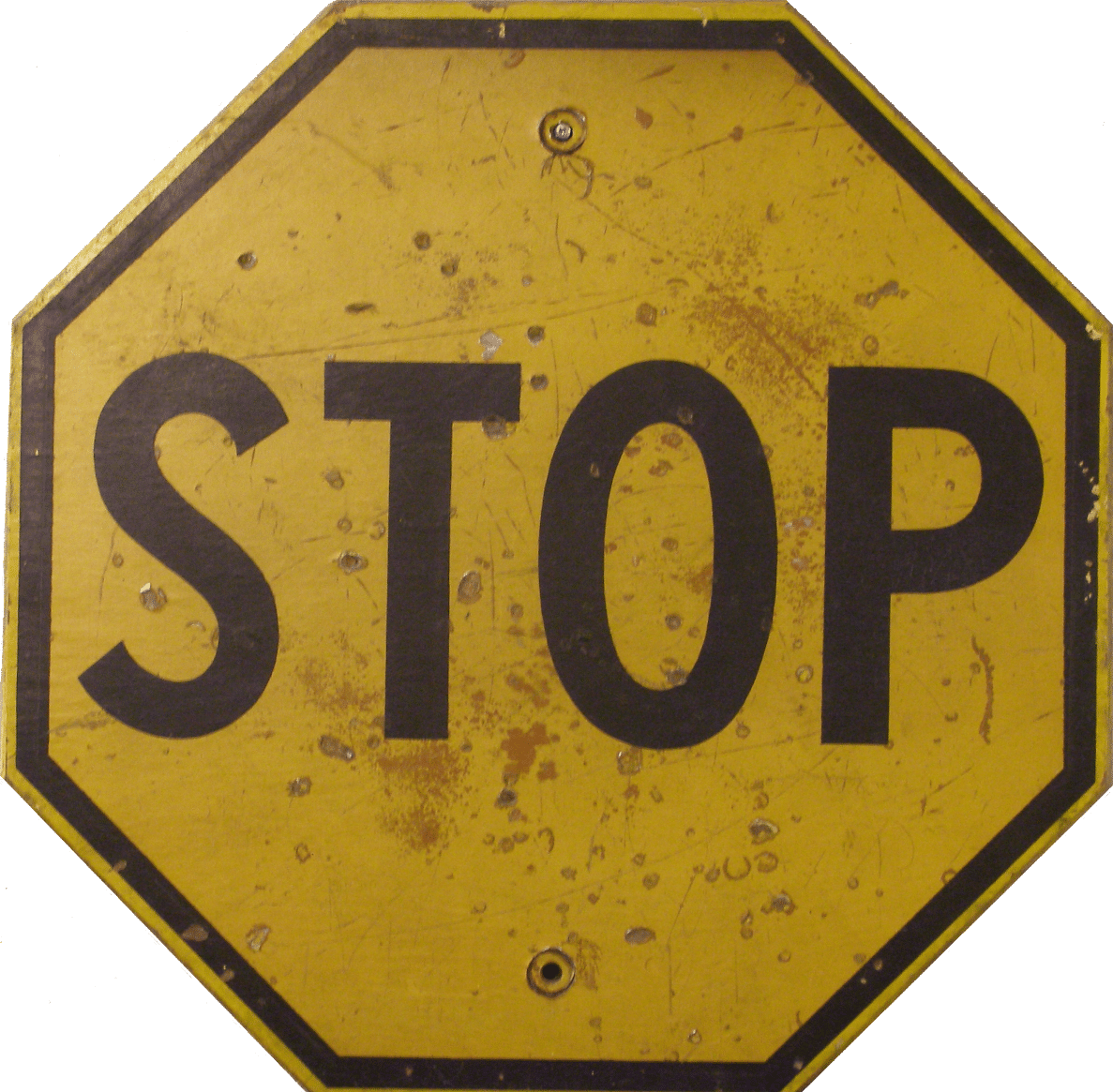
Stops signs in Gig Harbor weren’t always red with white lettering. Before those, they looked like this one. Photo by Greg Spadoni.
Like the ones today, the last of the old yellow stop signs in Gig Harbor were reflective, although only the yellow background. There is no reason to reflect the color black. It wouldn’t stand out more at night.

The yellow on this stop sign reflects light, but the black doesn’t … or does it? With black being the color of darkness, how would we know? Photo by Greg Spadoni.
Could the change from yellow to red have anything to do with yield signs being yellow? Was being the only traffic sign in the shape of an octagon not enough for STOP? Did it want its own color too?
Is STOP such an exhibitionist that it wanted its letters to shine in the dark as much as its background? After all, it’s barking an order at every approaching vehicle. It obviously yearns to be noticed and listened to. The flashier and more brilliant it is, the more attention it commands.
Is octagonal the shape of an elitist sign? Or the sign of an elitist?
In spite of all the self-centered things we can ascribe to STOP, the real reason for the color change is probably that reflective red with reflective white letters is easier to see in most lighting conditions. Selfish motivation on the part of an inanimate object is unlikely to have been the cause of the change.
Or is that what STOP wants us to believe?
Moving along
We drew a second question from the subject of changing stop signs, which is:
In what other significant way, besides a change in color, did the old stop signs differ from stop signs today?
Answer: Stop signs today are made of an aluminum alloy. The old yellow stop signs in Gig Harbor were made of plywood.
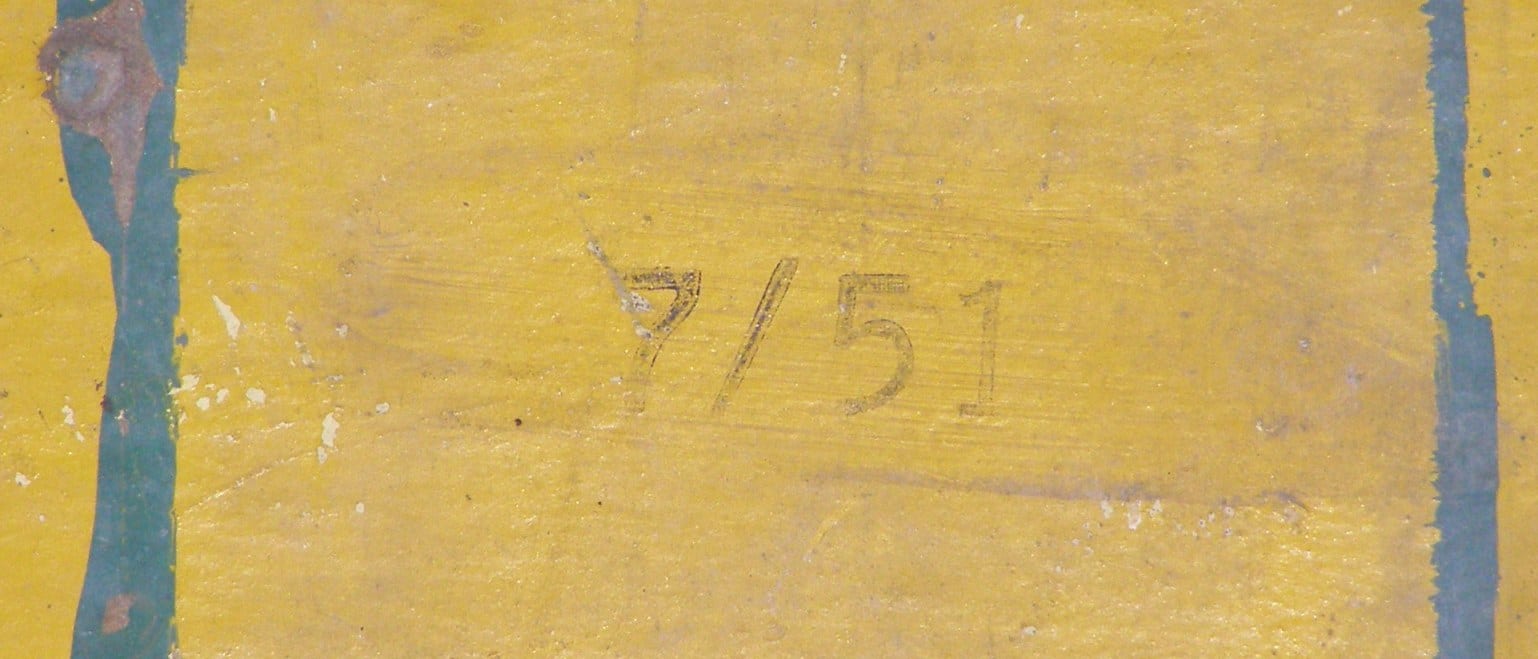
The numbers 7/51 stamped into the back of the yellow stop sign featured in this week’s column sure look like a date of manufacture, don’t they? Photo by Greg Spadoni.
Stop signs are not the only traffic signs made of an aluminum alloy. Almost all of them are. That brings up the question of why an aluminum alloy instead of pure aluminum? It’s to make them strong enough to resist bending in strong winds. Signs made of pure aluminum would be folded around their posts in tornadoes or hurricanes.
The red-with-white-letters stop sign below shows that the change to aluminum from plywood didn’t happen at the same time as the color change. (Stop signs were sometimes made of steel, but their tendency to rust lead to the preference for aluminum.)
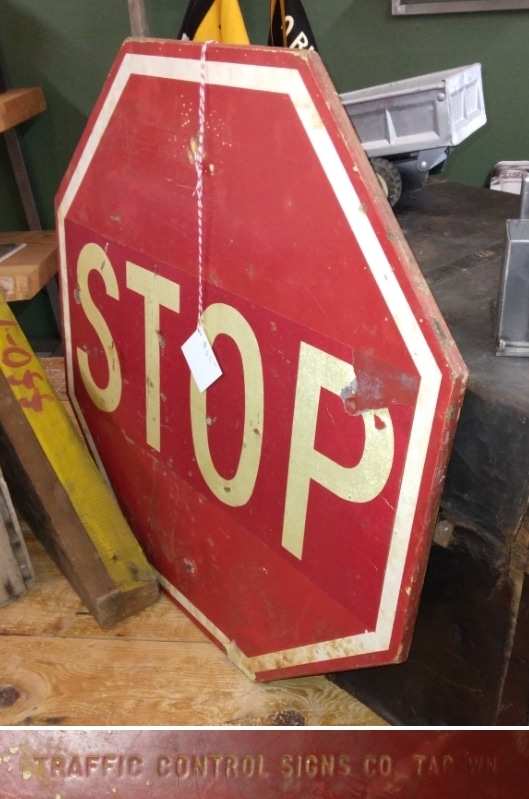
This red-with-white-letters stop sign is made of plywood. It was manufactured by a Tacoma company. Photo by Greg Spadoni.
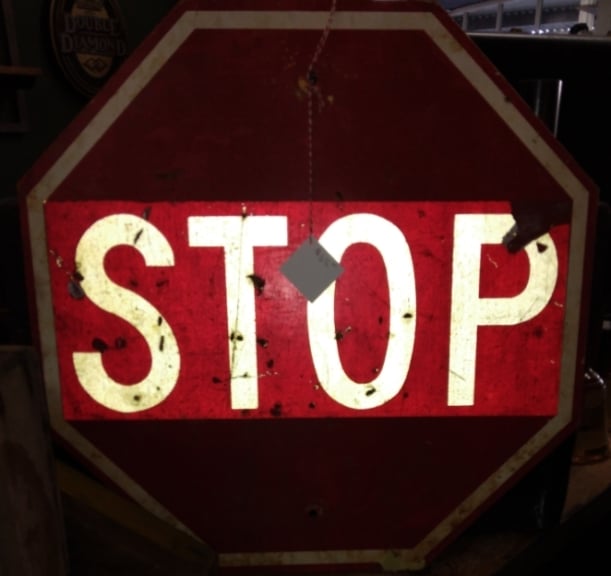
While both red and white colors reflect light on this plywood stop sign, only a part of the background is reflective. Photo by Greg Spadoni.
Reader Ned Kirk reminded me that some yellow stop signs were “sometimes self-lit with embedded lights or reflectors (like marbles) in the letters.” I do remember seeing a few of those, and as far as stop signs go, they were pretty highfalutin’. This link shows a good variety of stops signs from the Olden Days, most of them with the multiple small reflectors.
New business
Because Gig Harbor Now and Then rarely generates any reader response, and I’m not a member of Facebook, so can’t read the comments on the Gig Harbor Now Facebook page, it’s a complete mystery to me what readers like to read about and what they don’t. I have no way of knowing what topic or specific column is a hit or a miss. Appropriately, I carefully choose each new column topic by the common desperation tactic known as Grasping at Straws. This week’s grasped straw is a new feature likely to die a quick and quiet death. To give it a snazzy title, it shall be known during its probable very short life as The Historical Item of Mystery.
More casually, we’ll simply call it the Item of Mystery.
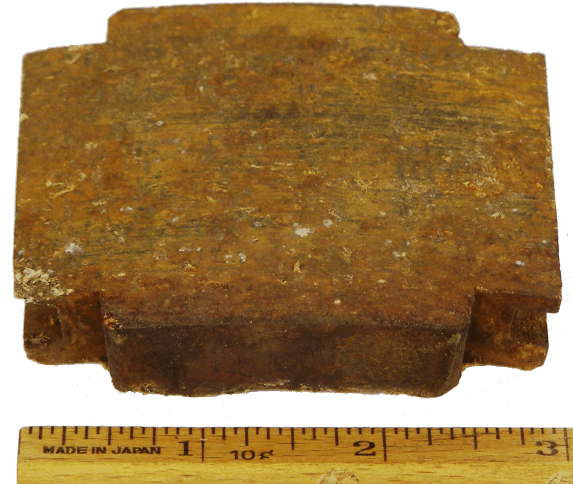
This is our very first (and potentially very last) Historical Item of Mystery. Unlike the ruler, it was definitely not made in Japan. Photo by Greg Spadoni.
This week’s Item of Mystery is difficult to identify. (If it wasn’t, it wouldn’t be much of a mystery, now, would it?) It does have a solid connection to Gig Harbor and the rest of the Peninsula, even though somewhere over 99.99% of the current population has never seen it, or any other like it.
A similar percentage of Gig Harbor Now and Then readers won’t find it the least bit interesting, but perhaps one or two will experience a measure of curiosity in the challenge. Some people simply can’t help themselves.
Along with our very first Item of Mystery comes a Heap O’ Hints (capitalized because it’s such a good phrase that it should be trademarked):
- Its size is completely misleading.
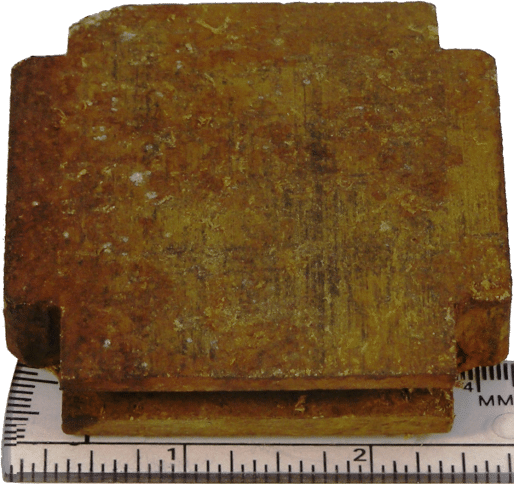
An end view of the Historical Item of Mystery. Photo by Greg Spadoni.
- This one is at least 78 years old, but there are newer ones in existence.
- The slight curvature is critically important in figuring out what it is. (Big, big hint there!)
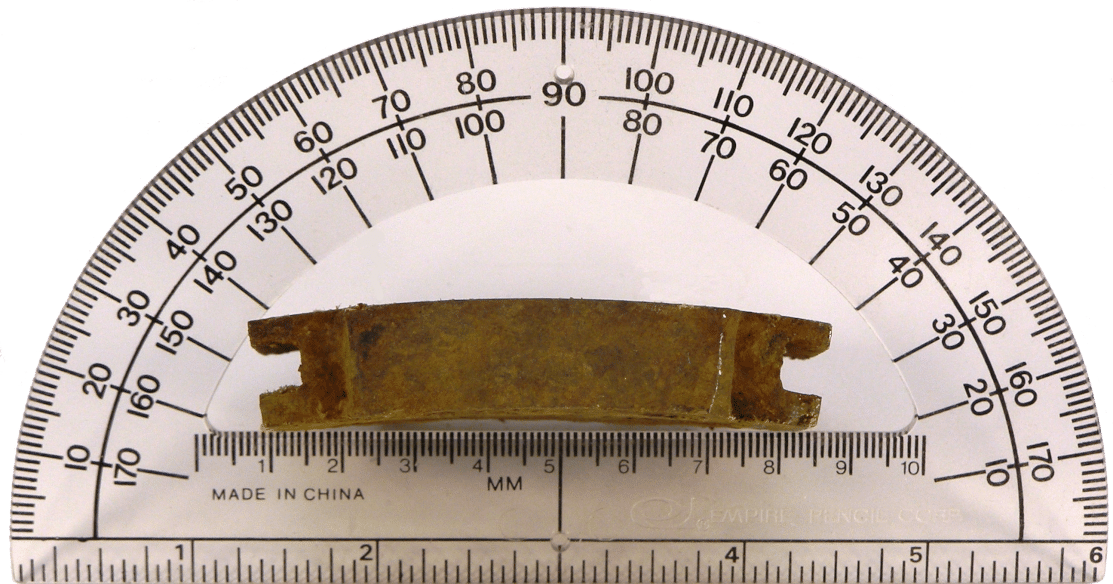
A side view of the Historical Item of Mystery shows its slight but critical curve. Photo by Greg Spadoni.
- It’s a rather mundane item that has been rendered super cool by the passage of time.
- It has a direct link to the Harbor History Museum, although nobody there knows that.
- Virtually all of the people who find out what it is couldn’t care less. (Which is a piddle-poor attitude, by the way, because as we stated two sentences ago, time has rendered it super cool.)
- More than half the readers who started reading this week’s column have dropped out before getting this far. (OK, so that’s not a hint, but it’s an interesting fact, isn’t it?)
No more hints this week
I’m not going to make the Historical Item of Mystery the question of the week, but if anyone should feel compelled to venture a guess, and if I happen to get wind of it, and if it’s correct, they will win a prize, whether they like it or not. That prize is worthy of being an Item of Mystery itself, but since the concept is unlikely to survive this trial run, here it is: the 19 Marlboro cigarettes left over from the photo shoot for Gig Harbor Now and Then No. 34. Besides being a priceless piece of Gig Harbor Now and Then memorabilia, it has an actual retail value of $10.50!

The shrewd history and hardware detective who correctly identifies the first Gig Harbor Now and Then Historical Item of Mystery is obligated to receive the 19 Marlboro cigarettes leftover from column #34, whether they want them or not. Photo by Greg Spadoni.
A non-local question of history
Staying with the theme of change, but switching from traffic signs to nationwide sports, how about that new NFL rule concerning kickoffs this season? The teams line up at an odd spot on the field, and nobody but the kicker and kick returners moves until the ball either hits the turf or is caught. It’s a very strange look for longtime fans.
It brings up recollections of other fairly dramatic rule changes, like outlawing roughing the passer, the horse collar tackle, and the flying wedge.
Some fans of the game don’t like certain rule changes, and some don’t like any changes. Complaints about changing football rules go back a long ways. This is one of them:
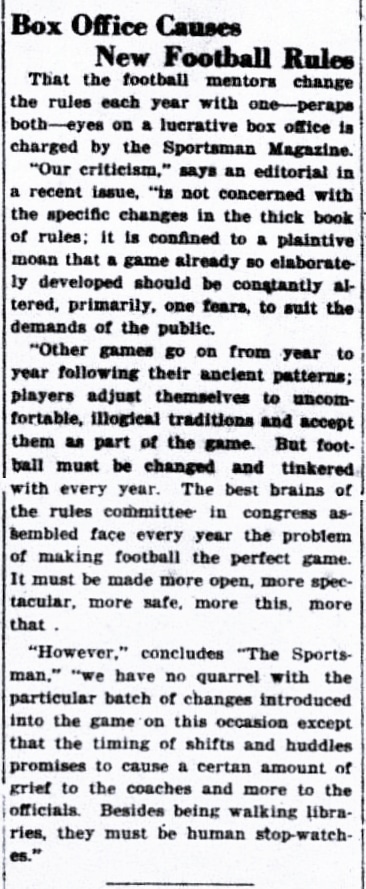
Dissatisfaction over the changing rules of football is nothing new.
Box Office Causes New Football Rules
That the football mentors change the rules each year with one — perhaps both — eyes on a lucrative box office is charged by the Sportsman Magazine.
“Our criticism,” says an editorial in a recent issue, “is not concerned with the specific changes in the thick book of rules; it is confined to a plaintive moan that a game already so elaborately developed should be constantly altered, primarily, one fears, to suit the demands of the public.
“Other games go on from year to year following their ancient pattern; players adjust themselves to uncomfortable, illogical traditions and accept them as part of the game. But football must be changed and tinkered with every year. The best brains of the rules committee in congress assembled face every year the problem of making football the perfect game. It must be made more open, more spectacular, more safe, more this, more that.
“However,” concludes “The Sportsman,” “we have no quarrel with the particular batch of changes introduced into the game on this occasion except that the timing of shifts and huddles promises to cause a certain amount of grief to the coaches and more to the officials. Besides being walking libraries, they must be human stop-watches.”
In what year was this article bemoaning constant changes in football rules published?
Next time
We’ll have the answer to the football rules question on Nov. 18. The new question will concern something associated with local sports, but not quite a sport itself.
The identity of the Item of Mystery won’t be revealed until somebody figures it out, which is highly unlikely. But there’s nearly a whole pack of smokes on the line, so who knows?
— Greg Spadoni, November 4, 2024
Greg Spadoni of Olalla has had more access to local history than most life-long residents. During 25 years in road construction working for the Spadoni Brothers, his first cousins, twice removed, he traveled to every corner of the Gig Harbor and Key Peninsulas, taking note of many abandoned buildings, overgrown farms, and roads that no longer had a destination. Through his current association with the Harbor History Museum in Gig Harbor as the unofficial Chief (and only) Assistant to Linda McCowen, the Museum’s primary photo archive volunteer, he regularly studies the area’s largest collection of visual history. Combined with the print history available at the Museum and online, he has uncovered countless stories of long-forgotten local people and events.

